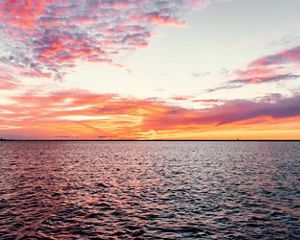The morning’s weather report had promised light winds and calm water, but the constant seesaw sway of Captain Paul Pacholski’s 30-foot fishing boat suggested that the report had been optimistic.
“We’ve got 30-mile-an-hour winds right now, and it seems to be building,” he said, grinning at the darkening sky at the stern. “Weather is not an exact science — it’s a lot like fishing.”
As a sportfishing charter-boat captain for three decades, Pacholski knows about both. Every day from early April to early November, he ferries boatloads of fishing enthusiasts from a marina near Toledo to the fishing grounds of Lake Erie’s western basin in search of walleye, smallmouth bass and yellow perch.
“The western basin is important because it is so biologically rich,” he says. “Its average depth is 24 feet, so you have warm, nutrient-rich water that holds an incredible food base. The larger the food base, the more top predators we have.”
Threats to Lake Erie
Growing up on the lake, he witnessed many changes, including the vast improvements to water quality brought about by the 1972 Clean Water Act and other regulations. But spending every day on the water gives Pacholski a first-hand look at many of the threats facing Lake Erie, including:
- Invasive species, like Asian carp that appear poised to enter the Great Lakes from the Mississippi River basin;
- Damming of rivers walleye use for spawning; and
- Excess algae that coats the surface of the lake, fed by the nutrients washing off the farmland of the Maumee watershed.
The Nature Conservancy knows how important Lake Erie is to both people and nature, and our scientists share Pacholski’s concerns. In Ohio and throughout the Great Lakes, we’re working on habitat protection and public policy initiatives, especially focused on two important tributaries – the Maumee and the Grand Rivers.
Fishing for Solutions
Our recent efforts to protect Lake Erie:
- We’re protecting and restoring wetland and floodplain habitat in the Maumee and Grand River watersheds
- We established Great Egret Marsh Preserve, which consists of more than 150 acres of marsh and surrounding upland in Ottawa County
- We’re working with state and federal regulators to track the spread of Asian carp
- We advocated for SB 1, a bill that prohibits the spreading of manure and chemical fertilizer - two major sources of the phosphorus - on frozen or saturated ground;
- We’re working with farmers as part of the voluntary 4R Nutrient Stewardship Certification program which aims to curb fertilizer run-off in order to reduce harmful algal blooms and improve water quality; and
- We're identifying and and demonstrating best practices that help slow the flow of water and stop nutrient loss, such as by two stage ditches, saturated buffers, water control structures and drainage water recycling systems.
Support Clean Water
Protecting Lake Erie, its tributaries & watershed will take an all hands on deck approach
.jpg?crop=0%2C97%2C2000%2C1100&wid=1300&hei=715&scl=1.5384615384615385)

